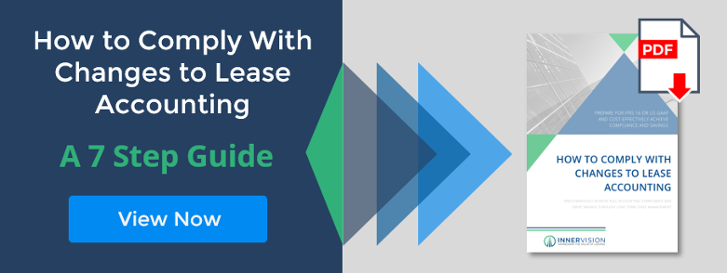Applying IFRS 16 – Where Should Companies Be Focusing Attention?
Updated 18th May 2021 | 6 min read Published 23rd October 2018

As the implementation deadline for new lease accounting edges ever closer. Where should companies be focusing their attention to ensure the deadline is met in an effective and timely maner. In this blog we explore the areas of focus organsiations should be pay particular attention to.
A quick recap:
This needs focusing on now because annual accounting periods from January 1st, 2019 IAS 17 is being replaced by IAS 17 and this is a standard that was officially published back in 2016, after many drafts and much consultation by the IASB – it should, therefore, be no surprise in itself but following implementations of IFRS 9 and IFRS 15 it really is time to train one’s resources again.
This new standard, just like IAS 17 before it deals with the accounting treatment of leases, but it is fair to say in a regulatory manner than just setting out guidelines to be interpreted.
1st January 2018 saw the deadline date for implementation of both IFRS 9 and IFRS 15 but for those charged with such compliance issues, there is little respite with just 3 months to go to meet the regulations and standards set out in IFRS 16.
Lessees will have a single accounting treatment for all leases
The main feature of the new standard is that rather than concentrating on the lease itself, which it does redefine, it recognises a lease only where it can identify an asset together with a “right to use” that asset. Who benefits from the right to direct the use of the asset and has substantially all of the economic benefits must place the asset on their balance sheet together with any contingent liabilities whether rentals, dismantling costs or indeed installation costs. Reporting of such an asset will need to include where appropriate purchase options, residual guarantees, termination option penalties and any variable lease payments. The treatment of the lease of an asset as an expense will cease with just a couple of exceptions around low value and short period hire. This applies retrospectively to any leases still extant and of course to all leased assets going forward.
Lessees will have a deadline to meet and need a plan to assemble their lease portfolio
Most companies it is hoped will now be well down the path of implementation having set up a project team to plan, prepare and execute the work required to bring their lease portfolio into a form that will allow it to be understood, reclassified where necessary and correctly treated from an accountancy perspective under IFRS 16. Finding the leases and assembling a portfolio from them is a task fraught with problems –
- who has the detail?
- where are the documents?
- who uses the assets?
- what are the return conditions?
- what are the rentals?
- How can one be sure that all property, IT, equipment, vehicles etc. included?
If this leg has not begun, then there is a way to go and a team needs to embark on this now!
Lessees need to review their portfolio and assess the impact of compliance
In reviewing the existing portfolio of leased assets, a company must focus on –
- Reclassification of operating leases as finance type leases from an accounting treatment perspective
- The expensing of any service element of any lease contract
- Generation of the necessary journals for general ledgers
- Setting of interest rates for reclassified operating leases
- Identification of lease expiry dates and options at lease end
- Accounting for any purchase, termination or extension options
- Clarification of all costs associated with the use of the assets subject to the leases
Lessees need to allocate resource and acquire a suitable and proven software solution to accelerate the path to compliance
With just 12 weeks to the deadline, it is now key that businesses
- Appoint a lead to complete the transition
- The lead needs the buy-in of the various divisions and users of leased equipment
- There is a financial task to be achieved by applying the new accounting treatment to existing leases
- There is an operational task to take the portfolio and make it available for impact assessment
- Forget spreadsheet solutions and filing cabinets – Think future! Think a chance to get things right!
- Investigate and evaluate a software-based solution that will ease all of the above
- If time is now critical then look at LOIS Lease Accounting from Innervision – suitable and proven and with an audit trail for variances and updates to leases
With the above in mind under IFRS 16:BC128, the lessee must take into account any periods that are likely to be non-cancellable under either termination options or extension options. Under IFRS 16:18 the lessee will include any such non-cancellable periods as part of the lease term calculation.
Lessees must communicate with all interested parties the impact of compliance on their financial results
There are many parties that need to know, appreciate and accept the ramifications of IFRS 16 compliance on the financials and the various gearing ratios
- All interest internal parties – procurement, accounting and users
- Any internal personnel measured and rewarded on such criteria
- All lenders to the business
- Stakeholders and potential investors
- Auditors (are you using any of the expedients? – see below)
- Internal interest setters
- Analysts
Lessees need to be aware of the practical expedients available
Accounting standards are continually being reviewed, clarified and replaced and the approach to the introduction and deployment of such new standards has resulted in increased consistency with the application of each. More recently the advent of new standards saw this in the “Conceptual Framework’s” requirement for costs imposed and recognised on preparers, regarding time and effort, having to be reflected in the benefits to users. This is evidenced in IFRS 15 by the ability to bundle similar service contracts into a single portfolio assuming that this would not result in any material misrepresentation or distortion of the financials relating to the contracts.
A similar approach is seen in the deployment of IFRS 16 and the practical expedients available under the standard. There are two ways of transitioning to the new standard and these approaches are, generally, referred to as
- Fully Retrospective
- Modified Retrospective
Practical expedients are available especially when following the Modified Retrospective Approach and these listed below can be reviewed with more detail in our blog “What are the practical expedients available under IFRS 16”.
- Treatment of Initial Direct Costs –
- Leases Expiring within 12 months of IFRS 16 Adoption –
- Discount Rate Application –
- Separating Out Non-Lease Components –
- Application of Hindsight –
- Expedients beyond Transition –
As you progress through transition and begin full-scale adoption of IFRS 16 other expedients may be brought to your attention by the IASB, your auditors or indeed a blog similar to this but the 6 listed above if applied where sensible or necessary will result in a smoother, less taxing, less resource gobbling implementation of the new lease accounting standard for your business and the associated people.
These are just a few of the ways Innervision’s lease management software can help your business. To find out more about the benefits our tools offer our clients, contact us today. If you’d also like to know more about the upcoming IFRS 16 regulations, take a look at how IFRS 16 will impact your accounting business and Innervision’s “New Lease Definition” or 7 step guide to lease accounting compliance.
Disclaimer: this article contains general information about the new lease accounting standards only and should NOT be viewed in any way as professional advice or service. The Publisher will not be responsible for any losses or damages of any kind incurred by the reader whether directly or indirectly arising from the use of the information found within this article.


